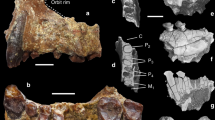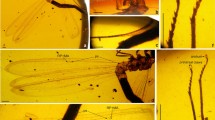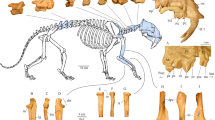Abstract
The erinaceomorph insectivorans, which include the living hedgehog and a diversity of archaic taxa1–3, have long been considered to be close relatives or direct ancestors of primates and a variety of other placental mammal orders4–6. We report here on the oldest known erinaceomorph basicranium which provides new evidence against the view that primates and erinaceomorphs share a close common ancestry.
This is a preview of subscription content, access via your institution
Access options
Subscribe to this journal
Receive 51 print issues and online access
$199.00 per year
only $3.90 per issue
Buy this article
- Purchase on Springer Link
- Instant access to full article PDF
Prices may be subject to local taxes which are calculated during checkout
Similar content being viewed by others
References
Butler, P. M. Proc. zool. Soc. Lond. 118, 446–500 (1948).
Krishtalka, L. Carnegie Mus. nat. Hist. Bull. 1, 1–40 (1976).
Russell, D. E., Louis, P. & Savage, D. E. Bull. Mus. natn. Hist. natn. 327, 129–193 (1975).
Gregory, W. K. Bull. Am. nat. Hist. 27, 1–524 (1910).
Simpson, G. G. Bull. Am. Mus. nat. Hist. 85, 1–350 (1945).
Szalay, F. S. in Phylogeny of the Primates, a Multidisciplinary Approach (eds Luckett, W. P. & Szalay, F. S.) 91–125 (Plenum, New York, 1975).
Novacek, M. J. Contr. Geol. Univ. Wyoming 20, 135–149 (1982).
Simpson, G. G. Am. J. Science 246, 257–282 (1948).
Simpson, G. G. Am. J. Science 246, 363–385 (1948).
Maier, W. Palaeont. Z. 53, 38–62 (1979).
Dechaseaux, C. Ann. Paléont. (Vertébrés) 1964, 83–100 (1964).
Rich, T. H. V. Bull. Am. Mus. nat. Hist. 171, 1–116 (1981).
MacPhee, R. D. E. Contr. Primatol. 18, 1–282 (1981).
Novacek, M. J. Mammal Rev. 7, 131–149 (1977).
Archibald, J. D. J. hum. Evol. 6, 609–622 (1977).
Cifelli, R. L. J. Paleont. 56, 795–805 (1982).
Conroy, G. C. & Wible, J. R. Folia Primatol. 29, 81–85 (1978).
MacPhee, R. D. E., Cartmill, M. & Gingerich, P. D. Nature 301, 509–511 (1983).
Presley, R. Acta anat. 103, 238–244 (1979).
Novacek, M. J. in Macromolecular Sequences in Systematic and Evolutionary Biology (ed. Goodman, M.) 3–41 (Plenum, New York, 1982).
Le Gros Clark, W. E. The Antecedents of Man 1st edn (Edinburgh University Press, 1959).
Szalay, F. S. & Drawhorn, G. in Comparative Biology and Evolutionary Relationships of Tree Shrews (ed. Luckett, W. P.) 133–169 (Plenum, New York, 1980).
McKenna, M. C. Folia primatol. 4, 1–25 (1966).
Szalay, F. S. & Delson, E. Evolutionary History of the Primates (Academic, New York, 1979).
Author information
Authors and Affiliations
Rights and permissions
About this article
Cite this article
Novacek, M., McKenna, M., Neff, N. et al. Evidence from earliest known erinaceomorph basicranium that insectivorans and primates are not closely related. Nature 306, 683–684 (1983). https://doi.org/10.1038/306683a0
Received:
Accepted:
Issue Date:
DOI: https://doi.org/10.1038/306683a0
Comments
By submitting a comment you agree to abide by our Terms and Community Guidelines. If you find something abusive or that does not comply with our terms or guidelines please flag it as inappropriate.



